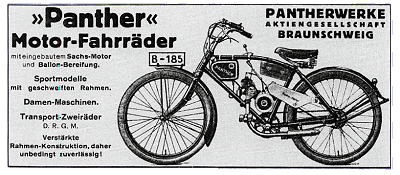
1931 Panther Sportmodelle
During the mid-1890s, the popularity of cycling in Germany was rising rapidly, and the few already existing cycle producers seemed unable to satisfy increasing public demand, resulting in the foundation of a number of new bicycle manufacturers establishing companies to cash-in on the business.
The original Panther-Fahrrad-Werke Ernst Kuhlmann & Co was founded at Magdeburg in 1896, and quickly established a range of machines from standard two-wheel ‘safety’ cycles, through cardan (shaft-drive) cycles, multi-seat tricycles and quadra-cycles, and even offering a motorcar to fill their comprehensive catalogue. The business was re-titled Panther Fahrradwerke in 1900 (possibly suggesting that Ernst Kuhlmann may have left involvement with the business), and recorded a further change of ownership to Oscar Vormbaum in 1907. At the same time as Panther was established in 1896, Braunschweiger Fahrradwerke AG (Brunswick Cycle Works) was founded to manufacture wheels and sewing machines under the Brunsviga brand.
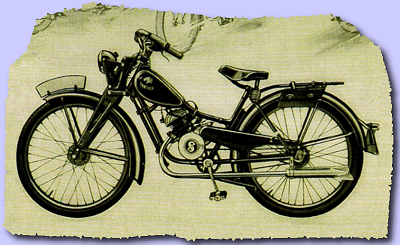
1938 Panther 8 T-A Damen Modell
Despite rumours of a doubtful reputation for its wheels in the early years, the company managed to improve its quality and soon enjoyed increased sales until, by 1906, even a motor cycle model was being offered for sale. In 1907 the businesses of Panther Fahrradwerke and Braunschweiger Fahrradwerke AG were merged as Pantherwerke AG, resulting in the closure of production at Magdeburg in favour of all works moving to Braunschweig. Production of bicycles, sewing machines and motor cycles under both Panther and Brunsviga brands continued until 1909, when motor cycles were dropped. In 1910 Pantherwerke took over the cycle production of the Minden Machine & Bicycle factory of Hoppe & Homann, so extending its programme to tempo (speed pacing) bicycles, and transferring their manufacture into the Braunschweig works.
The Great War seemed to be slow in affecting Pantherwerke’s business since late into 1915 a comprehensive the catalogue of cycles was still being offered in a range of colours and special fitting options, but nothing is known of its activities in the years 1916-19.
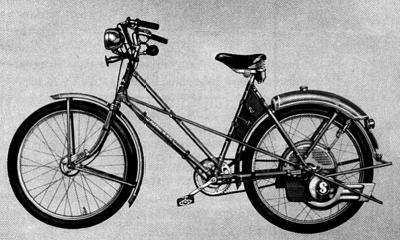
1938 Panther Saxonette
During the period of national inflation in the early 1920s, Pantherwerke was cautious not to extend its range during a time when prices were dramatically increasing, and only after the currency reform of 1923 did the commercial situation begin to stabilise again. In 1925 the main building was extended to assume the production of baby carriages, dolls, and children’s cycles. As Germany rode into the years of the Great Depression during 1930, Pantherwerke changed its plated finish from nickel to chrome and re-launched manufacture of motorised vehicles in 1931 with three autocycle models powered by 74cc Sachs engines. These were lightweight and economic machines, and proved the right choice for difficult times. Despite the business generally posting loss-making years throughout the 1930s, a further ten Panther-branded autocycle models were produced with 98cc Sachs engines, including a K40 kick-started light motor cycle and a Saxonette motor wheel propelled cycle. Pantherwerke maintained relatively normal production of its autocycles into 1940, and even listed the Modell 15/16 into 1942. The making of footstools had also been introduced since the beginning of the war, and prams continued throughout 1941, but the factory had been entered on armaments company lists and, from 1943 onwards, was turned over to making airframe components for Junkers. During the war years, Pantherwerke had actually managed to turn profits and emerged to resume post-war general production in 1946. 1948 saw the presentation of a new TS98 autocycle, followed by a further KS98 autocycle in 1951, and a ‘Panther Baby’ cyclemotor, powered by an NV Interpro 32cc attachment engine built under license from Berini.
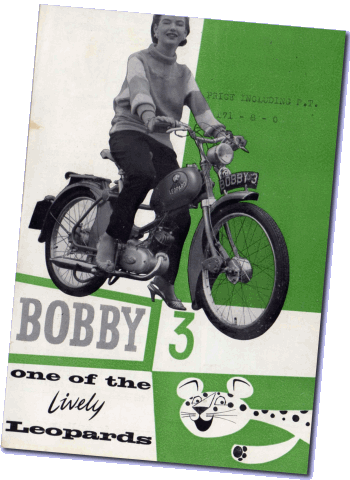
Around this time, industrial situations were developing to introduce another brand to the portfolio…
Somewhat similarly to Panther, the Bielefeld Sewing Machine and Bicycle Factory had been established at the town of Bielefeld in 1895, and also built early Fafnir-engined motor cycles up to 1903. In 1906 the company was taken over by Hengstenberg & Co of Bielefeld, resulting in reformation of the two businesses as Anker-Werke AG. In 1930 Anker began building 74cc motorised bicycles powered by Fichtel & Sachs engines, then 98cc autocycles from 1934 and, in 1938 introduced the 60cc ‘Sichegabel’ (Free-fork) Saxonette motor wheel bicycle. Production of autocycles, cycles and Saxonettes continued until 1940 but, in 1944 the factory was largely destroyed during an allied bombing raid. In 1945 Anker set about re-establishing its manufacturing, and returned to the motor cycling market with one of its revived pre-war autocycles, now called model 660, which was built at Maschinenbau AG Paderborn. Another 662 autocycle version came in 1950 and 662A in 1951, up to 1953, when the entire capital of the company had been consumed under the name of the Paderborn subsidiary PAMAG (Paderborner Maschinenfabrik AG. A meeting of the board of directors subsequently decided to sell PAMAG and the Anker brand onto Pantherwerke AG in 1953. Panther then began branding and marketing its Braunschweig built bicycles under the Anker badge. The Anker autocycle was discontinued at the transfer of business, while another Panther KS99 autocycle succeeded the previous KS98 model in 1953, and motor cycles of 150cc, 175cc, and 250cc joined the new range. 1954 presented new mopeds with rigid rear frame and sprung fork, the Bobby-1 powered by a two-speed Sachs 48cc engine, and Bobby-2 with an automatic single-speed Saxonette. The new motor cycles were constructed at Paderborn for selling under the Anker and Panther brands, while the new mopeds (also sold under both Anker and Panther labels), were built at the Anker Bielefeld factory up to 1958 when production facilities would be rationalised to react to the changing market.
The automatic Bobby-2 model earned little interest, and was dropped at the end of the year, while the Panther Bobby-1 was developed with a leading-link fork and evolved into the Bobby-3 model for 1955. Other changes included a switch from 26-inch wheels to 23-inch, the addition of valances to the mudguards, and a pressed-steel rear carrier to replace the tubular carrier of Bobby-1. Along with the Bobby-3 came a more substantially built Bobby-4, but that was still only a single-seat model. 1956 brought another single-seat Bobby-5 model with trailing-link forks, and Bobby-6 with telescopic front fork was also available with options of single or dual-seat.
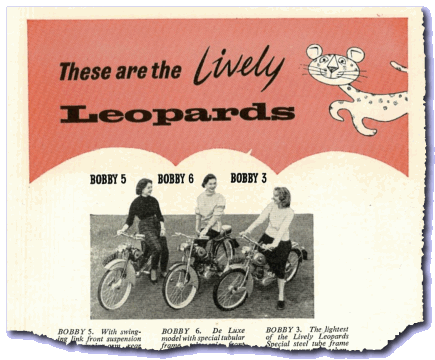
Imported by Christie & Sadler of London, three Pantherwerke Mk3, Mk5 and Mk6 Bobby moped models were introduced to the UK in July 1956, but since Phelon & Moore Ltd of Cleckheaton had previously registered the Panther brand in Britain, there needed to be a name change for the new mopeds. The ‘Leopard’ nom de plume matched the wild cat head logo, and had the same number of letters as Panther, so the black anodising screen was simply changed for the aluminium tank badges. The mopeds were supported by announcement of further Leopard scooters and a KS175S motor cycle, but there is little evidence to support any of these actually being sold in the UK.
The Bobby-3 was the simplest and cheapest of the Leopards, with rigid rear frame and leading-link front suspension, although its solid construction doesn’t appear as if much economy of materials was a consideration paramount during the design. The tubular frame is a sturdy combination of traditional brazed lug and welded construction on the lower sections, which looks quite minimal, but it is actually a very rigid assembly, and feels surprisingly heavy when you try lifting the bike by what appears to be a handle section within the middle of the frame. In the manner of a number of continental mopeds of the period, it looks as if the lower section of the upper frame tube might be doubling up as a carry point, but pick up here, and the bike proves unbalanced as the front dips down and the weight makes itself most apparent. The 19-inch Magmeg alloy rims and pressed aluminium chain guard certainly don’t feel as if they’re making much contribution to weight reduction, and rolling Bobby-3 onto the scales shows 2st 1lb front and 3st 3lb rear for a total of 6st (or 38kg if you prefer), and not so heavy really, so it’s just the uncomfortable out-of-balance lift that gives a false impression. The front forks are topped on their crown by a brass pressing, which may seem a little extravagant, but it’s probably an economical way of trimming the assembly by simply covering up the welded junction. The two-speed hand-change gears are located forward for first, neutral in the middle, and back for second (top), with the gears indexed by releasing the clutch lever on the Magura manual change.
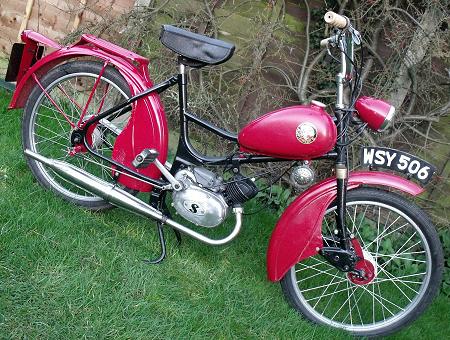
This 1.6ps (bhp) Sachs engine has chain primary drive, and a 12mm Bing carburetter. Starting is about as simple as they come, with no decompresser and no choke, it just comes down to whether or not to push the flood button on the carburetter? We give the pedals a spin without tickling the flood, and Leopard fires right up first time! OK, it’s running, but it sounds a bit of a loose and growly engine that is clearly going beyond its best days. Notch into first, then feed in the clutch while opening the throttle … and Leopard pulls strongly away from the line despite the grumbly nature of its motor. There’s no speedometer fitted, so our pacer is clocking of our readings, and it feels as if the Bobby-3 easily pulls through its first ratio, so we switch into second and it pulls the higher ratio well enough again. Continuing to accelerate, we soon appreciate that the drive ratio is quite low, so expect the Leopard to run out of legs towards the top of its range. A shallow hill climb is capably completed, which the bike pulls well due to its low gearing, but once we get onto the flat the motor revs rise quickly to climb to an angry buzz, and you just know it’s surely going to be revving out even on the flat. Sure enough, our pacer clocks 28mph into a headwind, and 30mph with a tailwind on the flat, then wringing its neck and, tucking in as much as we can, 32mph downhill. Limited by its low gearing, which was typical of many of these early and low power Sachs two-speed motors of the period, that’s fairly representative of what you might expect. The compression ratio of these early Sachs engines was only 6:1 and, fitted with a small 12mm Bing carburettor, there shouldn’t be any expectation of spectacular performance. The cycle handles firmly enough, though you certainly feel the rigid rear frame over bumps, and the spartan seat doesn’t help!
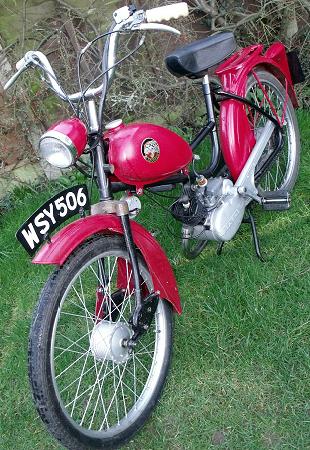
Both brakes proved capable enough for the performance, and the back pedal rear brake remained most effective despite its linings being obviously exhausted as the brake could stick on when the shoes went over-cam. The Bosch magneto set only has a generator output of 6V × 18W, so bulbs will be rated 15W front and 3W rear. The German Hella headlamp worked in a typically 1950s’ dim kind of way, and we noted the lamp bracket and number plate with Miller rear lamp, which would have been standard fitment requirements for selling onto the British market. The pressed carrier over the rear mudguard was also a standard fitment, though this would have originally included a sprung parcel clip to secure any luggage. Both front and rear mudguards are partially valanced to reduce spray in the wet.
Imports of Bobby-3 ceased in May 1957, while the original Bobby-6 was replaced by a MkII version at the same time, and continued with the Bobby-5 up till the end of 1957, when Christie and Sadler decided not to renew the import licence for the following year, but were still selling off remaining stocks into the 1958 season. The licence was taken up under new concessionaires: Cabin Scooter (Assemblies) Ltd of London, who resumed imports again in December 1958, listing B5 two-speed and three-speed models for 1959, then B5, B8, and B10 saw the last of the Leopards in 1960. At a posted price of £71-0s-0d, the Leopard Bobby-3 was the cheapest and most basic model of the range, but is also the rarest survivor of the brand, since it was only listed for a mere 11 months.
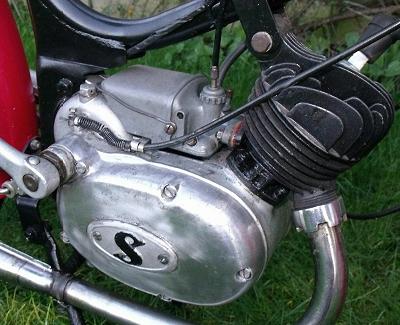
During the 1950s Pantherwerke’s business proved quite successful with a high export share to its production but, by the end of the decade, the market was changing dramatically. Overcapacity in the cycle trade was becoming squeezed by cheaper manufacturers establishing abroad, while the motor cycle trade was losing sales to a more affluent public who were now spending their money on motor cars. Declining sales figures brought a short-term co-operation with the Munich Rex-Works at the end of the 1950s, but with a production portfolio heavily biased toward cycles and motor cycles, Pantherwerke could not escape the general crisis of the two-wheel industry. Its turnover collapsed dramatically, while last desperate efforts toward the manufacture of children’s furniture seemed to deliver little real hope of salvation. Use of the ‘Bobby’ name technically ended at Model-8, though the moped series continued as B-8, through B-9, K-9, and B10 ‘Twin Sport’ up to 1962 when the company assets were sold to Schminke-Werke at Bad Wildungen, and the Braunschweig site was finally closed on 1st March 1963, at which time the brand was credited with having built some 1.2 million vehicles. Panther cycles and mopeds were also sold under the Anker badge on the German home market, as Leopard mopeds in the UK, and some mopeds and motor cycles were further branded as ‘Jaguar’ for sales into Finland and other international markets.
The end however, was not the end … the Panther brand continued under new ownership, producing Panther 501 Saxonette automatic and 542 sports mopeds, 543 and 545 LKF Mo-Kick, and 650S sports 50cc motor cycles up to 1965 when the business switched toward building office machines with the Anker brand, and finally ceased this business in 1976. Pantherwerke AG still continues as one of the largest suppliers to the bicycle retail trade in Germany, and belongs to the Panther International GmbH group, which includes UAB Baltic Vairas in Šiauliai (Lithuania), Master Bike Ltd in Zábřeh (Czech Republic), and further sales companies in Germany, Sweden, and Lithuania. The Panther International companies yearly produce towards ½-million bicycles under its own brands of Panther and Göricke, as well as other contract labels. Pantherwerke AG is now further specialising in development and production of Pedelecs and E-bikes.

